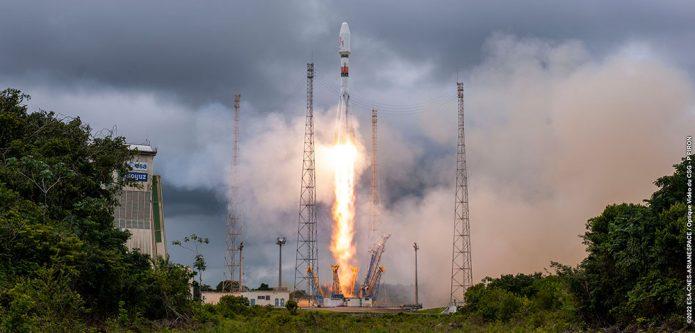Russia Orbits First Sfera Constellation Satellite

A Soyuz launch.
Roscosmos Space Corp. has launched the first satellite of Russia’s new Sfera multisatellite communication and Earth observation constellation.
The Skif-D spacecraft was sent to orbit atop a Soyuz-2.1b medium-lift rocket from Vostochny spaceport on Russia’s Far East on Oct. 22. In about 4 hr., a Fregat booster delivered it to the final circular orbit at an altitude of 8,070 km. This was the first mission for Vostochny this year.
This 160-kg satellite developed by ISS-Reshetnev Co. is a demonstrator that will test communication protocols for broadband internet connectivity and stake out a certain orbital frequency.
The future Skif subconstellation is expected to be fully deployed in 2027-2029. It will consist of 12 satellites that will operate in three orbital planes. The serial satellites will be almost four times heavier, about 600 kg, than the demonstrator and carry multibeam, phased antenna arrays to transmit and receive Ka-band data.
Sfera will also have more than 300 other communication and Earth monitoring satellites, united into a joint information system. Most of them are to be orbited in 2024-2026.
Skif-D flew to space as an additional payload to three Gonets-M satellites. These 280-kg spacecraft are used to provide various government monitoring and communication services in Russia and abroad from low circular orbit of 1,500 km. Since 2005, 25 satellites have been orbited, while the Gonets-D1M constellation became operational in 2015. Roscosmos plans to launch two more trios of these satellites in 2024-2025.
The recent launch was the first one for the Soyuz-2 to use naphthyl–a hydrocarbon fuel with the use of polymeric additives which is more powerful than kerosene–to power all three stages. Naphthyl was earlier used to fuel only Soyuz-2 upper stages.
Roscosmos says the transition to the new fuel is caused by the exhaustion of the only deposit with a unique sweet oil with a low freezing point in Southern Russia, which was used for production of traditional rocket kerosene. However, the fully naphthyl-fueled Soyuzes can operate only from Vostochny.
The Skif-D mission was Russia’s 17th in 2022. October is likely to become Russia’s busiest launch month for this year as the country has already sent five different rockets to space from its all three spaceports in a single month.